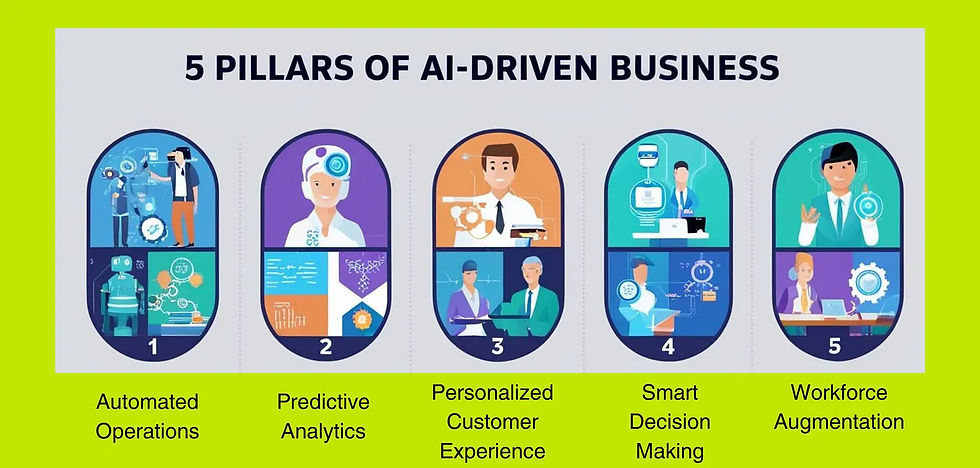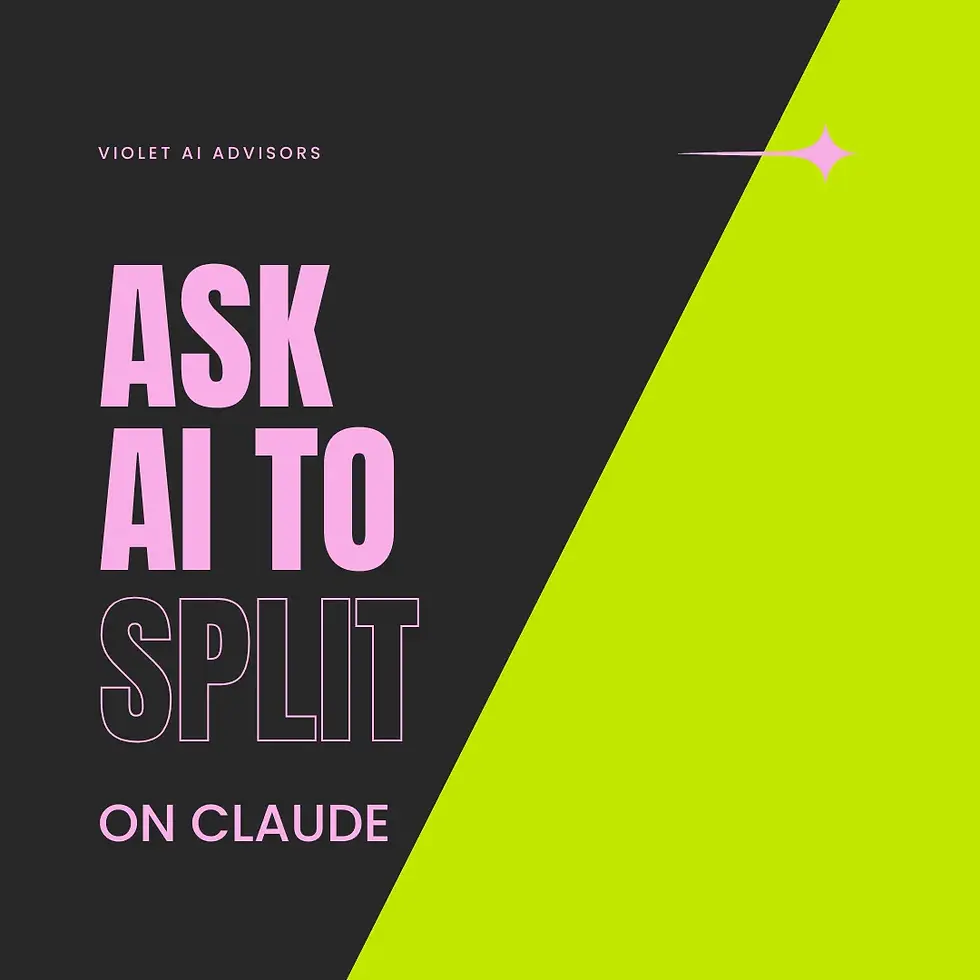Business Transformation with AI: 2025 Predictions
- Violet AI Advisors

- Feb 4
- 4 min read
The New Era of Intelligent Enterprise
--------
AI isn’t just the future—it’s the now. And in 2025, it’s rewriting the rules of business as we know it. With global AI investments set to skyrocket past $190 billion and 75% of enterprises already integrating AI into their core operations, the message is loud and clear: adapt or risk irrelevance. This isn’t just about keeping up with the competition; it’s about outpacing them, redefining your industry, and claiming your spot at the top. Check out our guide to AI in 2025 below:

Automated Operations: Implementation of AI systems that handle routine tasks, workflow management, and process optimization, reducing human intervention by up to 80% in repetitive tasks. This includes intelligent document processing, automated resource allocation, and smart scheduling systems.
Predictive Analytics: Advanced AI algorithms analyzing historical and real-time data to forecast market trends, customer behavior, and operational challenges with 90%+ accuracy. Businesses can anticipate changes and make proactive decisions rather than reactive ones.
Personalized Customer Experience: AI-powered systems creating hyper-personalized interactions across all touchpoints, using real-time data analysis to predict customer needs and preferences with unprecedented accuracy. This includes customized product recommendations, dynamic pricing, and automated customer service.
Smart Decision Making: Integration of AI-driven insights into strategic planning and decision-making processes, using complex data analysis to identify opportunities and risks. This includes real-time market analysis, competitive intelligence, and scenario planning.
Workforce Augmentation: AI tools enhancing human capabilities rather than replacing them, with intelligent assistants, automated research tools, and AI-powered productivity solutions becoming standard in the workplace.
2. Key Statistics & Predictions (2025 Outlook)
Global AI Market Value: Projected to exceed $190 billion, with a CAGR of 37.3% from 2023-2025. This growth is driven by increased adoption across all business sectors and the maturation of AI technologies.
Enterprise AI Adoption: 75% of enterprises will have fully implemented AI solutions in their core business processes, with 90% reporting significant ROI within the first year of implementation.
Automation Impact: 85% increase in AI-powered automation leading to a 40% reduction in manual processes and a 30% increase in overall operational efficiency.
Cost Reduction: 40% average reduction in operational costs through AI implementation, with some organizations reporting savings of up to 60% in specific departments.
Customer Satisfaction: 60% improvement in customer satisfaction metrics through AI-powered service enhancements, personalization, and faster response times.
3. Absolutely Transformative AI Technologies
Large Language Models: Advanced LLMs capable of understanding context and nuance at near-human levels, revolutionizing content creation, customer service, and business communication. These models will handle complex tasks like contract analysis, report generation, and multilingual communication.
Computer Vision: Sophisticated visual recognition systems enabling quality control, security surveillance, and automated inspection processes with 99.9% accuracy. Applications include inventory management, facial recognition for security, and defect detection in manufacturing.
Generative AI: Creation of original content, designs, and solutions through AI, transforming product development, marketing, and creative processes. This includes automatic code generation, design creation, and content production.
Robotic Process Automation (RPA): Enhanced RPA systems combining traditional automation with AI for more complex decision-making and adaptive process handling. These systems can handle exceptions and adapt to changing conditions automatically.
Neural Networks: Advanced neural networks capable of processing complex patterns and relationships in data, enabling more sophisticated prediction models and decision-making systems.
4. Industry-Specific Transformations
Healthcare:
AI-powered diagnostic systems with 95% accuracy
Personalized treatment plans based on genetic and lifestyle data
Automated patient monitoring and predictive health alerts
Drug discovery acceleration by 60%
Administrative task automation reducing costs by 35%
Finance:
Real-time fraud detection with 99.9% accuracy
Automated trading systems handling 75% of transactions
Personalized banking experiences for each customer
Risk assessment completion in minutes instead of days
AI-driven investment strategies outperforming traditional methods by 25%
Manufacturing:
Smart factories reducing downtime by 45%
Predictive maintenance saving 40% in maintenance costs
Quality control improvement of 35%
Supply chain optimization reducing logistics costs by 30%
Energy consumption reduction of 25% through AI optimization
5. Implementation Challenges and Solutions
Data Privacy & Security:
Implementation of advanced encryption methods
Regular security audits and compliance checks
Data anonymization techniques
Strict access control protocols
Regular staff training on data protection
Skill Gap & Training:
Comprehensive employee upskilling programs
Partnerships with educational institutions
Internal AI academies and learning platforms
Mentorship programs
Continuous learning initiatives
Integration Challenges:
Phased implementation approaches
Legacy system modernization strategies
API-first architecture adoption
Cross-functional team collaboration
Regular system compatibility assessments
Ethical Considerations:
Establishment of AI ethics committees
Regular bias audits and corrections
Transparent AI decision-making processes
Stakeholder engagement in AI governance
Regular impact assessments
AI is no longer a luxury or a buzzword—it’s your secret weapon, your unfair advantage, and your ultimate leadership hack. But let’s not sugarcoat it: the road to AI-powered greatness isn’t without its challenges. From navigating ethical dilemmas to bridging the skill gap, there’s work to be done. The good news? You don’t have to figure it out alone. We’re here to break it all down for you—the real deal on how to make AI work for you. Whether you’re a seasoned leader or a rising star, this is your moment to level up, take charge, and lead the AI revolution.


Comments